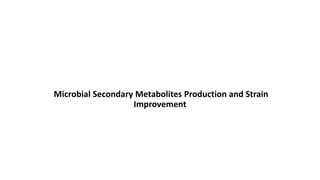
Microbial Secondary Metabolites Production and Strain Improvement.pptx
- 1. Microbial Secondary Metabolites Production and Strain Improvement
- 2. Introduction • Secondary metabolites (SM) are compounds with varied and sophisticated chemical structures, produced by strains of certain microbial species, and by some plants. • Although antibiotics are the best known SM, there are other such metabolites with an enormous range of biological activities, hence acquiring actual or potential industrial importance. • A characteristic of secondary metabolism is that the metabolites are usually not produced during the phase of rapid growth (trophophase), but are synthesized during a subsequent production stage (idiophase)
- 3. Introduction • Production of SM starts when growth is limited by the exhaustion of one key nutrient source: carbon, nitrogen or phosphate. • Most SM of economic importance are produced by actinomycetes, particularly of the genus Streptomyces, and by fungi.
- 4. Biosynthetic Families • It has been shown that SM are formed by pathways which branch off from primary metabolism at a relatively small number of points, which define broad biosynthetic categories or families: 1. Metabolites derived from shikimic acid (aromatic amino acids). Eg: ergot alkaloids and the antibiotics candicidin and chloramphenicol. 2. Metabolites derived from amino acids. Eg: β-lactam antibiotics like penicillin, cephalosporins and cephamycins. Cyclic peptide antibiotics such as gramicidin or the immunosupressive agent cyclosporine.
- 5. Biosynthetic Families 3. Metabolites derived from Acetyl-CoA (and related compounds, including Kreb's cycle inter-mediates). For example: • Polyketides like the antibiotic erythromycin, the insecticidal-antiparasitic compound avermectin and the antitumour agent doxo-rubicin. • Terpenes like the non citotoxic antitumour agent taxol. 4. Metabolites derived from sugars. Eg: streptomycin and kanamycin
- 6. Biosynthetic Families • Secondary biosynthetic routes are related to the primary metabolic pathways so they use the same intermediates and regulatory mechanisms. • These regulatory mechanisms include induction, carbon catabolite regulation and/or feedback regulation.
- 7. New Bioactive Compounds • Microbial SM are now increasingly being used against diseases previously treated only by synthetic drugs, e.g. as anti-inflammatory, hypotensive, antitumour, anticholesterolemic, uterocontractants, etc. • New microbial metabolites are being used in non medical fields such as agriculture, with major herbicides, insecticides, plant growth regulators and environmental friendly herbicides and pesticides as well as antiparasitic agents.
- 8. Production of SM Liquid Fermentation: • Secondary metabolites are generally produced in industry by submerged fermentation (SmF) by batch or fed-batch culture. • An improved strain of the producing microorganism is inoculated into a growth medium in flasks and then transferred to a relatively small fermenter or "seed culture". • Several parameters, like medium composition, pH, temperature, agitation and aeration rate, are controlled.
- 9. Solid-state Fermentation • This is a microbial culture that develops on the surface and at the interior of a solid matrix and in absence of free water. • Solid-state fermentation (SSF) holds an important potential for the production of secondary metabolites. • There are two types of SSF, depending on the nature of solid phase used: 1. Solid culture of one support-substrate phase. 2. Solid culture of two substrate-support phase
- 10. Solid-state Fermentation • In Solid culture of one support-substrate phase, the solid phase is constituted by a material that assumes, simultaneously, the functions of support and of nutrients source. • Agricultural or even animal goods or wastes are used as support- substrate. • In Solid culture of two substrate-support phase the solid phase is constituted by an inert support impregnated with a liquid medium. • Inert support serves as a reservoir for the nutrients and water. • Materials as sugarcane bagasse pith or polyurethane can be used as inert support.
- 11. Solid-state Fermentation • Fungi and actinomycetes, the main micro-organisms producer of SM grow well is SSF, because the conditions are similar to their natural habitats, such as soil, and organic waste materials. • The advantages of SSF in relation with SmF include: • Energy requirements of the process are relatively low, since oxygen is transferred directly to the microorganism. • SM are often produced in much higher yields, often in shorter times and often sterile conditions are not required. • In SSF, parameters to control are similar to the ones controlled for SmF • Particular parameters like initial moisture content, particle size and medium concentration have to be optimized in this culture system.
- 12. Strain Improvement • It is the science and technology of manipulating and improving microbial strains, in order to enhance their metabolic capacities for biotechnological applications. • Strain improvement can be performed by two alternative strategies: 1. Classical genetic methods (including genetic recombination) 2. Molecular genetic methods. • Each has distinct advantages, and in some cases all these approaches can be used in concert to increase production.
- 13. Strain Improvement • In classical genetic methods the strain development is relied on mutation, followed by random screening. • After this, careful fermentation tests are performed and new improved mutants are selected. • In molecular genetic Methods the strain development is relied on the cloning and analyzing of the biosynthetic gene or genes.